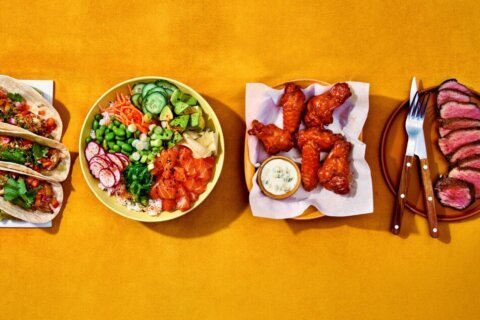Dieters often have an all-or-nothing mentality.
They cut out all their favorite foods — pizza, pasta, tacos, fries and cookies — to lose weight, but then they feel deprived, get discouraged and quit before they’ve reached their goal, says Dawn Jackson Blatner, a Chicago-based registered dietitian nutritionist. “I run into this issue with everybody.”
Blatner, who has helped thousands of people trim down over the past 15 years in her private practice and online classes, recommends a different strategy: Satisfy those cravings by swapping superfoods (vegetables, fruits, whole grains, nuts and other plant-based foods) for C.R.A.P., her acronym for overly processed foods that contain: Chemicals you don’t use in your kitchen; Refined flour and sugar; Artificial sweeteners, colors and flavors; and Preservatives.
[See: 15 Best Weight-Loss Diets at a Glance.]
She outlines her fix to dieters’ deprivation dilemma in her new book, “The Superfood Swap: The 4-Week Plan to Eat What You Crave Without the C.R.A.P.” (Houghton Mifflin Harcourt, $25.99). The secret to the plan is that dieters satisfy their cravings instead of denying them. Practically speaking, that means you:
— Eat a slice of sprouted whole-grain toast with 2 tablespoons of almond butter and mashed fruit sprinkled with chia seeds instead of a Pop-Tart or bagel for breakfast.
— Have plain 2 percent Greek yogurt with fresh berries instead of berry-flavored yogurt.
— Enjoy brewed chai tea instead of a chai latte or other high-calorie specialty coffee drinks.
— Quench your thirst with sparkling water with a shot of juice instead of a sugary drink.
— Eat sliced chicken, turkey breast, tuna, hummus or a homemade bean burger instead of processed meats.
— Treat yourself to a small piece of dark chocolate and cup of mint tea instead of packaged cookies and cakes.
She says more than a thousand people have tried the superfood swap, and many have reported good results. One dieter on the plan lost 53 pounds in 14 weeks and won the ABC reality TV show “My Diet is Better Than Yours,” which aired last year.
Swapping has some scientific support. One small study suggests when people start eating more wholesome food, they can retrain their brain to automatically crave more nutritious fare, says Blatner, who is also the author of ” The Flexitarian Diet,” which tied for No. 4 in the U.S. News Best Diets Overall ranking.
She recommends dieters become more calorie-conscious but not obsessed or oblivious. The meals in “The Superfood Swap” are about 400 calories each, so consuming three meals a day plus two snacks of 100 to 200 calories each equals about 1,400 to 1,600 calories a day. People who follow the plan will lose 2 to 4 pounds a week, depending on their starting weight and how much they exercise, she says.
In the first week of the plan, Blatner recommends eating more superfoods, which she calls the “rock stars” of the nutrition world because they deliver the maximum dose of vitamins and other nutrients. Her list includes vegetables and fruits; beans and lentils; organic eggs; sustainable fish; yogurt; whole grains and potatoes; nuts and seeds; healthy fats (like olive oil); herbs and spices. It also includes organic grass-fed beef, pasture-raised poultry and pork and flavorful cheese. When it comes to beverages, she suggests water, tea and moderate amounts of coffee and alcohol.
During the second week on the program, Blatner advises going on a C.R.A.P.-cutting mission. Scour your refrigerator, freezer and cabinets for overly processed foods by reading ingredient lists, she says. High on the list of C.R.A.P. offenders: packaged cookies and other baked sweets; packaged crackers, chips and other snack foods; sausage and bacon; soda (diet or sugar-sweetened); and white bread and rolls. She emphasizes that she loves some processed foods, such as frozen fruits and vegetables without added sauces.
[See: 7 Ways to Hack Your Grocery Trip for Weight Loss.]
In week three of the program , she outlines ways to make superfood choices when dining out, entertaining and vacationing, and in week four, she offers suggestions to maintain motivation with new ideas for food and fitness.
Food science continues to evolve, Blatner says, but research findings suggest that a diet with a variety of whole foods is healthier than one packed with overly processed foods. “No one food will ever be the magic bullet,” she adds.
Other nutritionists agree. “It makes common sense to eat more whole foods, even though some of the science is still emerging,” says Keith Ayoob, a registered dietitian nutritionist in New York City. “I like the concept of the book, which is basically to embrace your cravings with healthy foods and nutrient-rich ingredients. That’s a great premise to build on. You can retrain your palate over time.”
The recipes in the book will be “an introduction to a lot of new flavors,” says registered dietitian nutritionist Edith Howard Hogan of the District of Columbia. Some of dishes, such as cauliflower mac and cheese, sprouted pizza and lentil tacos “are inventive and certainly nutritious, but they may require a special trip to the grocery store to fill your pantry.”
Boston nutritionist Elizabeth Ward, blogger at betteristhenewperfect.com, says she likes the fact that Blatner’s book is practical. “Her love of food comes through,” Ward says. “A lot of diet books miss out on that. They are more about deprivation.”
For those looking for easy ways to prepare healthier meals, Blatner recommends shortcuts such as buying bagged, pre-cut, prewashed greens (lettuce, spinach, kale, arugula, pre-shredded coleslaw), which can go directly into a salad, soup, omelet or stir-fry or can be used as toppings on sandwiches. Other ideas: Use canned beans and look for cooked whole grains (precooked brown rice or quinoa), which can be found in the freezer or refrigerator section of the grocery store.
[See: The 12 Best Heart-Healthy Diets.]
One simple way to use the plan: Make sure half your plate is vegetables, which have the most nutrients for the fewest calories. The rest of it should consist of smaller portions of whole grains, proteins, fats and fruits. An easy way to increase your intake of vegetables is to create a green base, using three cups of your favorite salad greens or other cut vegetables, and then top it with about 400 calories of other foods, such as small bites of pizza, Chinese leftovers, chopped hard-boiled eggs or a scoop of your favorite pasta dish.
Other ideas for superfood swaps:
— Use chopped nuts to coat chicken or fish for a crunch instead of frying.
— Use roasted potato cubes instead of refined white flour croutons on salads.
— Make lentil tacos, lentil meatballs and black-bean burgers instead of ground-beef versions.
— Use pureed fruit instead of maple syrup on pancakes and French toast.
— Substitute frozen banana slices or frozen grapes for ice cream.
— Make open-faced sandwiches piled high with vegetables, such as cucumber, mushrooms, red bell pepper, zucchini and watercress, on just one slice of sprouted whole-grain bread, which is more nutritious than wheat or multigrain options, Blatner says. You often find this kind of bread (one popular brand is Ezekiel) with other organic foods in the freezer section of the grocery store, she says.
Blatner says the bottom line is that “it’s all about super swapping to get better nutrition while still eating what you crave. Your taste buds and body will love you for it.”
More from U.S. News
The 38 Easiest Diets to Follow
U.S. News’ 38 Best Diets Overall
The 12 Best Heart-Healthy Diets
How to Lose Weight With Superfood Swaps originally appeared on usnews.com







